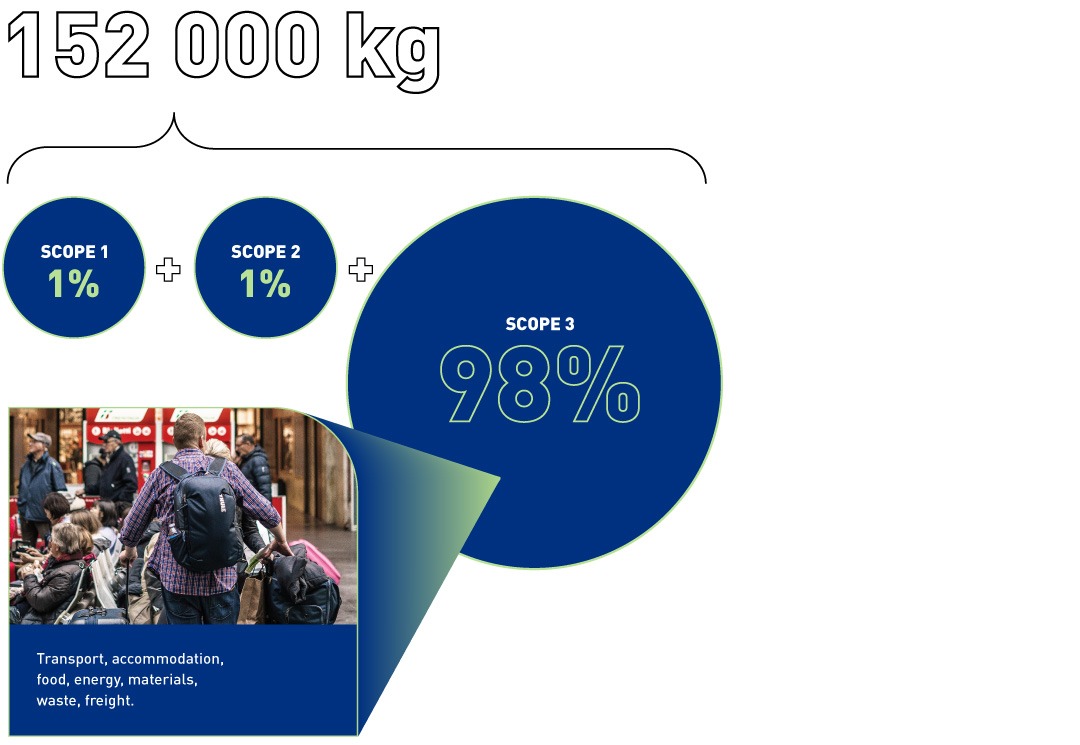Rimi Riga Marathon’s carbon footprint will be compensated for the first time in the Baltics with Neste Latvija support
25 January 2023The Rimi Riga Marathon has become the first large-scale sports event in the Baltics, which has evaluated its impact on the environment by performing CO₂ᵉ emission or carbon footprint calculations. In the extensive sustainability audit, which was carried out for almost a year with the support of Neste Latvija, evaluating three classic scopes – self-created emissions, indirect emissions from received and consumed electricity, and indirect emissions created by participants, it was concluded that the largest running event in the Baltics generated 152,663 kg of CO₂ᵉ emissions.
The Rimi Riga Marathon is determined to compensate for its footprint by investing in emission-reducing environmental infrastructure improvement projects in the city of Riga with the support of Neste Latvija, and by supporting the planting of several thousand pines and spruces throughout Latvia. CO₂ᵉ compensation is a unique innovation in the organization of large mass events – the organizers of the Rimi Riga Marathon hope that their example will encourage other sectors, companies, and events to focus on evaluating their impact on the environment.
The purpose of the Run for Future by Neste marathon sustainability program, within which the sustainability audit of the Rimi Riga Marathon was carried out, is to minimize the environmental impact of the biggest national sports event in the Baltics, encouraging both runners’ communes and society, as well as the event industry (and not only) to focus on a sustainable lifestyle.
We all leave a footprint behind us. Even the marathon, however green and fluffy it may be, leaves a footprint. However, thanks to Neste, we are the first national sports event in the Baltic region to not only assess our impact on the environment by calculating CO₂ᵉ emissions or footprints but also compensate for our footprint by investing in sustainable and emission-reducing projects in Riga and Latvia. We will also continue to improve the processes of producing and organizing the marathon and, of course, we will talk relentlessly with our own - the runners' commune, marathon partners, and society, so that each of us is aware of our footprint and takes more and more care of it ourselves.
Aigars Nords
Rimi Rīgas maratona organizatoru komandas vadītājs
At Neste, we work according a clear principle - if you don't initiate changes, if you don't challenge the existing status quo, don't be surprised if nothing changes. But the world has no time to wait. Therefore, together with the Rimi Riga Marathon, we have decided to take confident steps to understand the impact of this event, educate the public and jointly commit to compensate and reduce emissions in the long term by initiating meaningful environmental projects from which many will benefit.
Armands Beiziķis
Chairman of the Board of Neste Latvija

The Sustainability Audit of the Rimi Riga Marathon was carried out as part of the Run for Future by Neste program in cooperation with the University of Latvia researcher and environmental expert Jānis Brizga, using the data available to the organizers, by surveying cooperation partners and the participants of the Rimi Riga Marathon.
The carbon footprint calculations included and evaluated all three classic scopes (scope 1-3) that organizations analyze to calculate their carbon footprint:
- Scope 1 – direct emissions or GHG (greenhouse gas) emissions that occur and are produced at the event/s and are controlled by the organizers, for example, fuel for the transport of runners.
- Scope 2 – Indirect GHG emissions from electricity received and consumed, such as the marathon EXPO, which takes place several days before the event, to issue bib numbers to runners, electricity produced, or electricity produced by generators at the event.
- Scope 3 – all other indirect emissions, produced banners, constructions, medals, energy points on the track, participants’ arrival in Riga, transport to the start, hotels, etc.

Rimi Riga Marathon carbon footprint compensation
Thanks to Neste Latvija, the sustainability partner of the Rimi Riga Marathon, the carbon footprint of the event (152,663 kg CO₂ᵉ) will be compensated for the first time in the Baltics. The lion’s share – 118,000 kg of CO₂ᵉ – of the carbon emissions created by the 2022 marathon has already been compensated by the Rimi Riga Marathon by financially supporting the planting of 3,000 pine trees in Mežapark and the planting of 3,000 spruce trees throughout Latvia.
The Rimi Riga Marathon, with Neste’s support, has committed to compensate for the remaining part of CO₂ᵉ by supporting an emission-reducing infrastructure project in the city of Riga, thereby doing good to its city, instead of compensating in third-world countries, which is a common practice in the world. The most appropriate infrastructure project is currently being identified in cooperation with the Riga City Council – it will be available to both runners and every resident and will be announced at the beginning of 2023.
We have previously reported on the Rimi Riga Marathon’s achievements in minimizing its carbon footprint and impact on the environment, by digitalizing a number of internal and external organizational processes over the past few years, as well as optimizing production and participants’ consumption choices. So, for example, the printing of marathon participants’ materials is reduced to a minimum, registration confirmations for receiving numbers are only online, participants’ bags made of recycled materials are only given to runners who have deliberately expressed such a wish, but Mangaļi water is served in recycled glasses, which are sorted after use.
In order to easily recognize the sustainability initiatives at the event, the Rimi Riga Marathon has introduced the Run for Future by Neste identification mark – if you notice such a mark on the official symbols, inventory, or other materials of the marathon, you can be sure that they are part of the marathon’s sustainability program.
Read more about the sustainability audit of the Rimi Riga Marathon and the Run for Future by Neste program in the Sustainability section of the Rimi Riga Marathon website.




